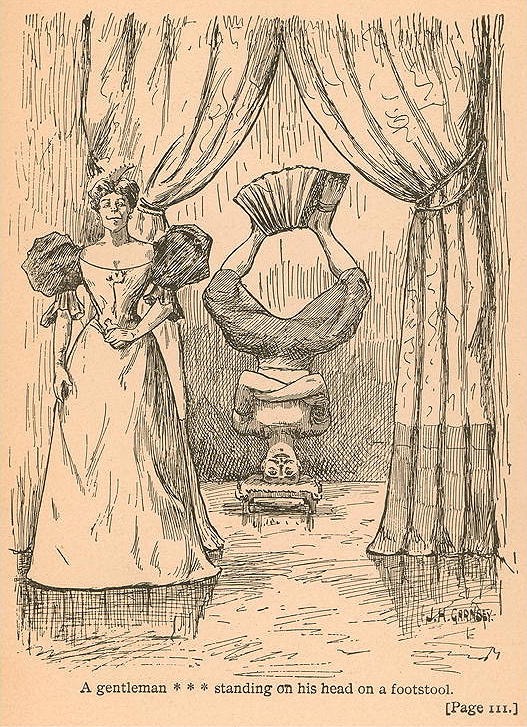Serializing

J. H. Garnsey: A gentleman . . . standing on his head on a footstool,
from Billtry, by Mary Kyle Dallas (New York: The Merriam Company, 1895).
An illustration from a dime novel.
"Whatever produces Ink, works."
A hundred and fifty years ago, many popular novels were published twice. They were first Serialized in a newspaper or weekly magazine, then later compiled into a book, sometimes in different editions ranging from cheap dime novels to leather bound presentation finishes. By the time a Dickens novel was published, it had already been read by tens of thousands, each novel already a best seller at the point of publication. The blog, I guess, replaces such Serialization in today's publishing world. For an Author, Serializing offers one great benefit over simply publishing books, a more frequent experience of "Ink," the term Authors use to describe what it feels like to see their work in print. We say that we've received ink as if we'd received a blessing or a sacrament or something similar. It might serve as the true purpose of Authoring, to receive a jolt of recognition when spotting one's own writing upon a page. ©2022 by David A. Schmaltz - all rights reserved
It doesn't matter to us Authors, either, whether that Ink comes in the form of a Letter To The Editor in a newspaper or a hard bound book. Last week, a colleague sent me a copy of her latest book in which she shared a story I'd shared with her, so while I hadn't written that book, I was still there upon the page, quoted. Even that bit of Ink delivered that jolt. I guess that Authors might be Ink junkies, working not always for money or recognition, but for the reassuring sense that we exist as attested to in Ink.
I've long thought that publishers should distribute their books in serialized form. Most readers time slice their reading, since few can carve out enough time to plow through any book in one sitting. Half hour slices seem just about right, the length of a New Yorker article, and something that one might well get clear through on a single commute. I can imagine newspaper stands selling serializations and commuters pulling their latest obsession and leaving their fifty cents before boarding their bus or train, but I suspect that I'm envisioning the past again, unable to make connection with what might be coming next or might already be here. Except that I am already present in the so-called medium of the future in the form of my PureSchmaltz Blog. Every morning, there's a fresh installment. I use Facebook as a prompt to my subscribers that a new installment's been posted. Almost the same publishing model Dickens employed, except that his Serializations paid him something for his trouble. Modern publishing's transcended the poisoning influence of money. One really, really does publish for love of Ink or, usually, one does not publish anything at all.
I sent off my first query letter of this series yesterday. I sent it to an industry insider, the founder of the house that published my Blind Men, giving them first dibs in recognition of our history. I had grown weary of the hoops I had proven myself incapable of leaping through, especially since, like Dickens', that manuscript had already earned scores of satisfied readers. The more I attempted to dress up the corpse of Serializing, the less lifelike it seemed, a paradox of deeply wounding proportions. The more I attempted to describe it, the less my descriptions resembled it. I resolved the paradox by performing an Anything But That, essentially turning in an incomplete paper just to enable my moving into a next layer, another chapter, another grade. It's not like any move might prove terminal. I might best consider each step of Authoring another installment in a never-ending Serializing, whether or not the result ever gets released as a book. Serializing produces a best seller before the follow-on book's even published. Whatever produces Ink, works.


